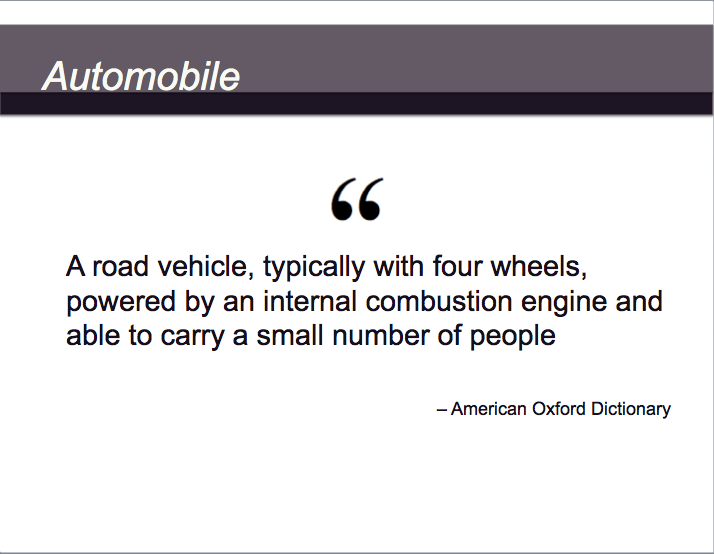If we want to design a program that helps people to learn, we talk about many things, including…
Providing the right kind of practice
I recently reviewed an elearning program, and I was struck by how difficult it can be to provide the appropriate practice.
An Easy Example
For concepts, it’s generally not enough to read and/or explain the definition to people. Here’s an easy example:

Words Alone Won’t Work Here. No matter how much we explain or define the terms in this definition with words, someone who has never seen a car before is going to have a tough time identifying one.
So what would be better? Any of these…
- Images of cars
- Toy cars
- Actual cars
And of course you’d need some examples of things that are like cars, but are not actually cars, like busses, motorcycles, and trucks.
Correct. The learners practice identifying which images, toys, or actual vehicles are cars and which are something else.
Incorrect. The learners practice memorizing the definition (unless it’s really necessary to be able to recite it).
A More Complicated Example
I was just reading some of Medicare’s rules about what makes up a legible physicians’ signature. Although this sounds like an oxymoron, meeting the signature requirements can make the difference between whether Medicare pays a claim or not.
What’s a rule? Rules are about desired relationships between concepts. Obviously, then, people have to be able to identify the concepts so that they can look for or create those relationships.
You have to learn the concepts before you can learn the rule. And look at how complicated this can be… this is for one small part of the rules about good signatures…

Do we need to provide the rule? Yes! And we probably want to translate the rule into plain language, too.
But here’s what else we need: electronic documents, online images, or paper examples of…
- Legible and illegible signatures with and without typed/printed names and letterhead
- Signature logs, some filled out correctly and some not
- Attestation statements, some filled out correctly and some not
- Various combinations of the examples above
- Definitions of each of these concepts
To learn the concepts, the learner practices until she can correctly categorize legible from illegible signatures and note whether a particular signature log or attestation statement includes the required elements.
To learn the rule, the learner practices with various combinations of documents (as would happen in real life) until she can confidently answer the question: Do we have everything we need to meet the signature requirement?
Often, the temptation is to ask the learner to memorize the definition of a concept or the text of a rule. Usually, that is not what we really need. Instead, what we want is for them to be able to…
- Sort the wheat from the chaff (examples of a concept from non-examples of that concept)
- Follow the rule
Where possible, spend most of the available time on practice—sorting examples and following rules. That way, instead of just talking about it, your learners will be able to get some work done.
Related Posts
It’s the Principle of the Thing: Predicting, Explaining, and Applying the Rules
